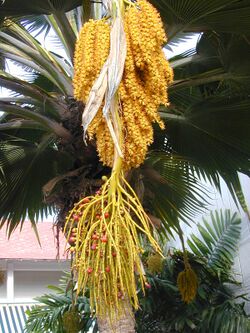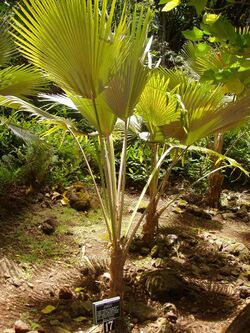Pritchardia
Topic: Biology
 From HandWiki - Reading time: 4 min
From HandWiki - Reading time: 4 min
| Pritchardia | |
|---|---|

| |
| Pritchardia sp. flowers and fruit on two pendulous stalks | |
| Scientific classification | |
| Kingdom: | Plantae |
| Clade: | Tracheophytes |
| Clade: | Angiosperms |
| Clade: | Monocots |
| Clade: | Commelinids |
| Order: | Arecales |
| Family: | Arecaceae |
| Subfamily: | Coryphoideae |
| Tribe: | Trachycarpeae |
| Genus: | Pritchardia Seem. & H.Wendl.[1] |
| Synonyms[2][1] | |
| |
The genus Pritchardia (family Arecaceae) consists of between 24 and 40 species of fan palms (subfamily Coryphoideae) found on tropical Pacific Ocean islands in Fiji, Samoa, Tonga, Tuamotus, and most diversely in Hawaii.[2][3] The generic name honors William Thomas Pritchard (1829-1907), a British consul at Fiji.[4]
Description
These palms vary in height, ranging from 6 to 40 m (20 to 131 ft).[5] The leaves are fan-shaped (costapalmate) and the trunk columnar, naked, smooth or fibrous, longitudinally grooved, and obscurely ringed by leaf scars. The flowers and subsequent fruit are borne in a terminal cluster with simple or compound branches of an arcuate or pendulous inflorescence that (in some species) is longer than the leaves.
Species
There are 29 known species, of which 19 are endemic to the Hawaiian Islands, with the remainder on other island groups. Many are critically endangered.
- Pritchardia affinis Becc. – Hawaiʻi Pritchardia[6] (Island of Hawaiʻi)
- Pritchardia arecina Becc. – Maui Pritchardia[6] (Maui, Hawaii)[5]
- Pritchardia aylmer-robinsonii H.St.John (Niʻihau, Hawaii)
- Pritchardia beccariana Rock – Kilauea Pritchardia[6] (Island of Hawaiʻi)[5]
- Pritchardia flynnii Lorence & Gemmill (Kauaʻi, Hawaii)
- Pritchardia forbesiana Rock – Mt. Eke Pritchardia[6] (Maui, Hawaii)
- Pritchardia glabrata Becc. & Rock (Maui, Hawaii)
- Pritchardia hardyi Rock – Makaleha Pritchardia[6] (Kauaʻi, Hawaii)
- Pritchardia hillebrandii (Kuntze) Becc.[6] (Native range uncertain, but believed to be Molokaʻi, Hawaii)[5]
- Pritchardia kaalae Rock – Waiʻanae Range Pritchardia[6] (Oʻahu, Hawaii)
- Pritchardia lanaiensis Becc. & Rock – Lānaʻi Pritchardia[6] (Lānaʻi, Hawaii)
- Pritchardia lanigera Becc. (Island of Hawaiʻi)
- Pritchardia limahuliensis H.St.John (Kauaʻi, Hawaii)
- Pritchardia lowreyana Rock – Molokaʻi Pritchardia[6] (Molokaʻi, Hawaii)
- Pritchardia maideniana (Unknown origin, possibly Fiji or Tonga)[5]
- Pritchardia martii (Gaud.) H.Wendl – Koʻolau Range pritchardia[6] (syn. P. gaudichaudii) (Oʻahu, Hawaii)
- Pritchardia minor Becc. – Alakaʻi Swamp Pritchardia[6] (Kauaʻi, Hawaii)
- Pritchardia mitiaroana Dransfield & Ehrhardt (Mitiaro, Cook Islands)[5]
- Pritchardia munroi Rock – Kamalo Pritchardia[6] (Molokaʻi, Hawaii)
- Pritchardia napaliensis H.St.John (Kauaʻi, Hawaii)
- Pritchardia pacifica Seem. & H.Wendl. (Fiji, Tonga, Samoa)
- Pritchardia pericularum
- Pritchardia perlmanii Gemmill (Kauaʻi, Hawaii)
- Pritchardia remota Becc. – Nihoa Pritchardia[6] (Nihoa, Hawaii)
- Pritchardia schattaueri Hodel – Giant Pritchardia (Island of Hawaiʻi)
- Pritchardia thurstonii F.Muell. & Drude (Fiji)
- Pritchardia viscosa Becc. – Stickybud Pritchardia[6] (Kauaʻi, Hawaii)
- Pritchardia vuylstekeana
- Pritchardia waialealeana R.W.Read (Kauaʻi, Hawaii)
- Pritchardia woodfordiana (Solomon Islands)
- Pritchardia woodii (Maui, Hawaii)
Formerly placed here
- Licuala grandis (hort. ex W. Bull) H.Wendl. (as P. grandis hort. ex W. Bull) (Vanuatu)
- Washingtonia filifera (Linden ex André) H.Wendl. (as P. filamentosa H.Wendl. ex Franceschi or P. filifera Linden ex André)[7] (Southwestern United States and Baja California)
Relationship with humans
Native Hawaiians (who call them loulu or noulu) often plant the trees in their traditional homes.[8] They often consume their seeds (known as hāwane or wāhane) raw,[9] use their trunk wood as building material and leaves as roof thatching in houses and temples.[8]
See also
References
- ↑ 1.0 1.1 "Genus: Pritchardia Seem. & H. Wendl.". Germplasm Resources Information Network. United States Department of Agriculture. 2007-10-05. Archived from the original on 2010-05-28. https://web.archive.org/web/20100528123049/http://www.ars-grin.gov/cgi-bin/npgs/html/genus.pl?9853. Retrieved 2010-12-11.
- ↑ 2.0 2.1 Kew World Checklist of Selected Plant Families
- ↑ Hodel, D.R. (2007). A review of the genus Pritchardia. Palms; Journal of the International Palm Society 51(Suppl.): 1-53.
- ↑ Quattrocchi, Umberto (2000). CRC World Dictionary of Plant Names. 3 M-Q. CRC Press. p. 2168. ISBN 978-0-8493-2677-6. https://books.google.com/books?id=kaN-hLL-3qEC.
- ↑ 5.0 5.1 5.2 5.3 5.4 5.5 Riffle, Robert Lee; Paul Craft (2003). An Encyclopedia of Cultivated Palms. Timber Press. pp. 419–422. ISBN 978-0-88192-558-6. https://books.google.com/books?id=rL3dHVJ2CZ8C.
- ↑ 6.00 6.01 6.02 6.03 6.04 6.05 6.06 6.07 6.08 6.09 6.10 6.11 6.12 6.13 "Pritchardia". Integrated Taxonomic Information System. https://www.itis.gov/servlet/SingleRpt/SingleRpt?search_topic=TSN&search_value=42461. Retrieved 2010-12-11.
- ↑ "GRIN Species Records of Pritchardia". Germplasm Resources Information Network. United States Department of Agriculture. http://www.ars-grin.gov/cgi-bin/npgs/html/splist.pl?9853. Retrieved 2010-12-11.
- ↑ 8.0 8.1 Meilleur, Brien A. (June 2022). "Ancient Hawaiian house lots and their flora: a review of Great Māhele plant claims with a special focus on Pritchardia (loulu) palms" (in en). Revue d'ethnoécologie (21): 16–20. doi:10.4000/ethnoecologie.9104. ISSN 2267-2419. https://journals.openedition.org/ethnoecologie/9104#tocto1n5.
- ↑ Chock, Alvin K. (1968). "Hawaiian Ethnobotanical Studies I. Native Food and Beverage Plants". Economic Botany 22 (3): 232. doi:10.1007/BF02861956. ISSN 0013-0001. https://www.jstor.org/stable/4252960.
External links
Wikidata ☰ Q311086 entry
 |
 KSF
KSF

